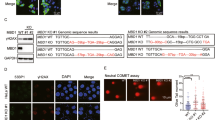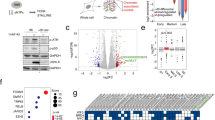Abstract
The transcriptional cofactor PC4 is an ancient single-strand DNA (ssDNA)-binding protein that has a homologue in bacteriophage T5 where it is likely the elusive replicative ssDNA-binding protein. We hypothesize that human PC4 has retained functions in ssDNA binding to stabilize replication forks and prevent genome instability in mammalian cells. Here we demonstrate that PC4 is recruited to hydroxyurea (HU)-stalled replication forks, which is dependent on active transcription and its ssDNA-binding ability. Interestingly, we demonstrate that ssDNA binding by PC4 is critical to suppress spontaneous DNA damage and promote cellular survival. PC4 accumulation co-localizes with replication protein A (RPA) at stalled forks and is increased upon RPA depletion, demonstrating compensatory functions in ssDNA binding. Depletion of PC4 not only results in defective resolution of HU-induced DNA damage but also significantly reduces homologous recombination repair efficiency. Altogether, our results indicate that PC4 has similar functions to RPA in binding ssDNA to promote genome stability, especially at sites of replication–transcription collisions.
This is a preview of subscription content, access via your institution
Access options
Subscribe to this journal
Receive 50 print issues and online access
$259.00 per year
only $5.18 per issue
Buy this article
- Purchase on Springer Link
- Instant access to full article PDF
Prices may be subject to local taxes which are calculated during checkout





Similar content being viewed by others
References
Barlow JH, Faryabi RB, Callen E, Wong N, Malhowski A, Chen HT et al. Identification of early replicating fragile sites that contribute to genome instability. Cell 2013; 152: 620–632.
Bartkova J, Rezaei N, Liontos M, Karakaidos P, Kletsas D, Issaeva N et al. Oncogene-induced senescence is part of the tumorigenesis barrier imposed by DNA damage checkpoints. Nature 2006; 444: 633–637.
Di Micco R, Fumagalli M, Cicalese A, Piccinin S, Gasparini P, Luise C et al. Oncogene-induced senescence is a DNA damage response triggered by DNA hyper-replication. Nature 2006; 444: 638–642.
Mortusewicz O, Herr P, Helleday T . Early replication fragile sites: where replication-transcription collisions cause genetic instability. EMBO J 2013; 32: 493–495.
Toledo LI, Altmeyer M, Rask MB, Lukas C, Larsen DH, Povlsen LK et al. ATR prohibits replication catastrophe by preventing global exhaustion of RPA. Cell 2013; 155: 1088–1103.
Zou L, Elledge SJ . Sensing DNA damage through ATRIP recognition of RPA-ssDNA complexes. Science 2003; 300: 1542–1548.
Vassin VM, Anantha RW, Sokolova E, Kanner S, Borowiec JA . Human RPA phosphorylation by ATR stimulates DNA synthesis and prevents ssDNA accumulation during DNA-replication stress. J Cell Sci 2009; 122: 4070–4080.
Feijoo C, Hall-Jackson C, Wu R, Jenkins D, Leitch J, Gilbert DM et al. Activation of mammalian Chk1 during DNA replication arrest: a role for Chk1 in the intra-S phase checkpoint monitoring replication origin firing. J Cell Biol 2001; 154: 913–923.
Steigemann B, Schulz A, Werten S . Bacteriophage T5 encodes a homolog of the eukaryotic transcription coactivator PC4 implicated in recombination-dependent DNA replication. J Mol Biol 2013; 425: 4125–4133.
Batta K, Yokokawa M, Takeyasu K, Kundu TK . Human transcriptional coactivator PC4 stimulates DNA end joining and activates DSB repair activity. J Mol Biol 2009; 385: 788–799.
Das C, Hizume K, Batta K, Kumar BR, Gadad SS, Ganguly S et al. Transcriptional coactivator PC4, a chromatin-associated protein, induces chromatin condensation. Mol Cell Biol 2006; 26: 8303–8315.
Ge H, Roeder RG . Purification, cloning, and characterization of a human coactivator, PC4, that mediates transcriptional activation of class II genes. Cell 1994; 78: 513–523.
Kretzschmar M, Kaiser K, Lottspeich F, Meisterernst M . A novel mediator of class II gene transcription with homology to viral immediate-early transcriptional regulators. Cell 1994; 78: 525–534.
Mortusewicz O, Roth W, Li N, Cardoso MC, Meisterernst M, Leonhardt H . Recruitment of RNA polymerase II cofactor PC4 to DNA damage sites. J Cell Biol 2008; 183: 769–776.
Pan ZQ, Ge H, Amin AA, Hurwitz J . Transcription-positive cofactor 4 forms complexes with HSSB (RPA) on single-stranded DNA and influences HSSB-dependent enzymatic synthesis of simian virus 40 DNA. J Biol Chem 1996; 271: 22111–22116.
Wang JY, Sarker AH, Cooper PK, Volkert MR . The single-strand DNA binding activity of human PC4 prevents mutagenesis and killing by oxidative DNA damage. Mol Cell Biol 2004; 24: 6084–6093.
Yu L, Volkert MR . Differential requirement for SUB1 in chromosomal and plasmid double-strand DNA break repair. PLoS One 2013; 8: e58015.
Suzuki K, Yamauchi M, Oka Y, Suzuki M, Yamashita S . Creating localized DNA double-strand breaks with microirradiation. Nat Protoc 2011; 6: 134–139.
Petermann E, Orta ML, Issaeva N, Schultz N, Helleday T . Hydroxyurea-talled replication forks become progressively inactivated and require two different RAD51-mediated pathways for restart and repair. Mol Cell 2010; 37: 492–502.
Arnaudeau C, Lundin C, Helleday T . DNA double-strand breaks associated with replication forks are predominantly repaired by homologous recombination involving an exchange mechanism in mammalian cells. J Mol Biol 2001; 307: 1235–1245.
Lundin C, Schultz N, Arnaudeau C, Mohindra A, Hansen LT, Helleday T . RAD51 is involved in repair of damage associated with DNA replication in mammalian cells. J Mol Biol 2003; 328: 521–535.
Werten S, Stelzer G, Goppelt A, Langen FM, Gros P, Timmers HT et al. Interaction of PC4 with melted DNA inhibits transcription. EMBO J 1998; 17: 5103–5111.
Sakaguchi K, Ishibashi T, Uchiyama Y, Iwabata K . The multi-replication protein A (RPA) system—a new perspective. FEBS J 2009; 276: 943–963.
Brandsen J, Werten S, van der Vliet PC, Meisterernst M, Kroon J, Gros P . C-terminal domain of transcription cofactor PC4 reveals dimeric ssDNA binding site. Nat Struct Biol 1997; 4: 900–903.
Kaiser K, Stelzer G, Meisterernst M . The coactivator p15 (PC4) initiates transcriptional activation during TFIIA-TFIID-promoter complex formation. EMBO J 1995; 14: 3520–3527.
Werten S, Moras D . A global transcription cofactor bound to juxtaposed strands of unwound DNA. Nat Struct Mol Biol 2006; 13: 181–182.
Alabert C, Bukowski-Wills JC, Lee SB, Kustatscher G, Nakamura K, de Lima Alves F et al. Nascent chromatin capture proteomics determines chromatin dynamics during DNA replication and identifies unknown fork components. Nat Cell Biol 2014; 16: 281–293.
Aymard F, Bugler B, Schmidt CK, Guillou E, Caron P, Briois S et al. Transcriptionally active chromatin recruits homologous recombination at DNA double-strand breaks. Nat Struct Mol Biol 2014; 21: 366–374.
Pierce AJ, Johnson RD, Thompson LH, Jasin M . XRCC3 promotes homology-directed repair of DNA damage in mammalian cells. Genes Dev 1999; 13: 2633–2638.
Acknowledgements
We would like to express our gratitude to Annette Medhurst and Songmin Ying for help with the fibre assay, Guy Kingham for assistance on the DR-GFP assay and to Mick Woodcock for support with the FACS analysis. This project was supported by the Swedish Research Council, Swedish Cancer Society, EMBO LTF (O.M. 451-2010), Dutch Cancer Society (BE), the Torsten and Ragnar Söderberg Foundation, AXA foundation and the Göran Gustafsson Foundation.
Author information
Authors and Affiliations
Corresponding authors
Ethics declarations
Competing interests
The authors declare no conflict of interest.
Additional information
Supplementary Information accompanies this paper on the Oncogene website
Supplementary information
Rights and permissions
About this article
Cite this article
Mortusewicz, O., Evers, B. & Helleday, T. PC4 promotes genome stability and DNA repair through binding of ssDNA at DNA damage sites. Oncogene 35, 761–770 (2016). https://doi.org/10.1038/onc.2015.135
Received:
Revised:
Accepted:
Published:
Issue Date:
DOI: https://doi.org/10.1038/onc.2015.135
This article is cited by
-
Transcriptional positive cofactor 4 promotes breast cancer proliferation and metastasis through c-Myc mediated Warburg effect
Cell Communication and Signaling (2019)
-
High-throughput Evaluation of Protein Migration and Localization after Laser Micro-Irradiation
Scientific Reports (2019)
-
An integrated bioinformatics platform for investigating the human E3 ubiquitin ligase-substrate interaction network
Nature Communications (2017)
-
Sub1/PC4, a multifaceted factor: from transcription to genome stability
Current Genetics (2017)
-
Positive Cofactor 4 (PC4) is critical for DNA repair pathway re-routing in DT40 cells
Scientific Reports (2016)



